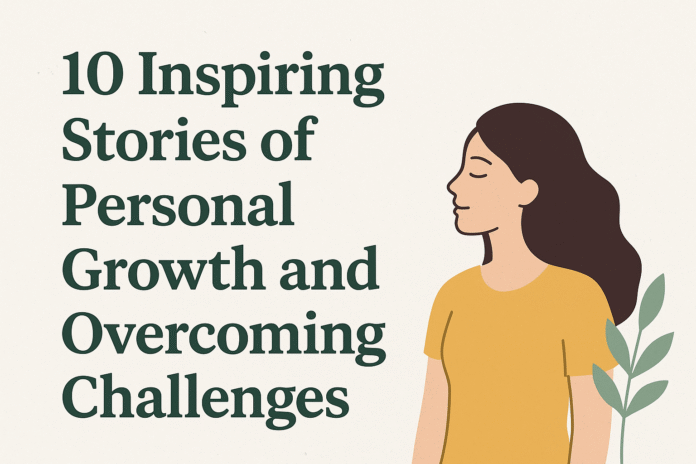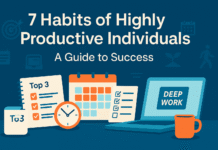Personal growth is a lived experience — a messy, exhilarating, sometimes painful process that reshapes who we are and what we can do. In this collection you’ll read ten true-to-life, relatable stories of people who faced real obstacles and built sustainable change. Along the way you’ll learn practical strategies, step-by-step actions, low-cost alternatives, ways to measure progress, and safety notes so you can adapt each approach to your life. This article is for everyday people who want tools and honest examples to get unstuck and grow.
Key takeaways
- Small, consistent actions beat occasional heroics — steady routines compound into change.
- Combination beats single-solution thinking — pairing psychological strategies (like cognitive reframing) with practical habits (like movement or journaling) produces stronger results.
- You can start with inexpensive tools — a notebook, a timer, a walking route, or a supportive person are often enough to begin.
- Measure progress kindly and flexibly — track habits, not perfection. Use simple metrics that encourage momentum.
- Safety matters — some strategies require professional support or medical clearance; there are signs to watch for and precautions to take.
Story 1 — Reclaiming Energy: A gradual exercise habit that changed a career trajectory
The story
Maya (early 30s) was a creative professional who woke up exhausted and disengaged. Long workdays, poor sleep, and a cycle of postponing exercise left her stuck. She began with short, daily walks and slowly added strength sessions. Months later she reported clearer thinking, better sleep, and renewed energy that helped her take on a leadership role.
What it is and core benefits
This is a progressive movement habit: start with low-barrier activity (walking) then layer more intense, strength-building sessions. Benefits include improved mood, energy, and cognitive clarity — outcomes that help professional performance and resilience. Research supports exercise as an effective treatment component for depressive symptoms and fatigue.
Requirements / prerequisites (and low-cost alternatives)
- Minimal equipment: comfortable shoes and a safe route.
- Later: a resistance band or basic free weights (low cost).
- Alternatives: stair climbing, active household chores, or online bodyweight workouts.
Step-by-step implementation (beginner-friendly)
- Week 1–2: Walk 10–15 minutes daily after a meal. Use a timer and keep the pace conversational.
- Week 3–4: Add two 20-minute bodyweight sessions (squats, push-ups from knees, planks).
- Month 2–3: Introduce one strength session with bands or light dumbbells, twice weekly.
Beginner modifications and progressions
- Modify push-ups by doing them on a wall or bench.
- Progress by increasing time, reps, or adding a third weekly strength session.
Recommended frequency/duration/metrics
- Walking: daily, 10–30 minutes.
- Strength: 2× per week, 20–30 minutes.
- Metrics: consistent days/week, minutes per session, perceived energy on a 1–10 scale.
Safety, caveats, and common mistakes
- Get medical clearance if you have chronic conditions.
- Avoid sudden high-intensity sessions if sedentary — build gradually.
- Common mistake: trying to “do it all” at once; stick to small increments.
Mini-plan (2–3 steps)
- Walk 12 minutes each weekday after lunch.
- Do 2×20-minute bodyweight sessions on Wednesdays and Saturdays.
Story 2 — Rewriting the story: using short, focused journaling to process a setback
The story
After a painful breakup and the loss of a job, Jamal (late 20s) felt overwhelmed. He began a ten-minute nightly journaling ritual: one paragraph about what went wrong, one paragraph about what he learned, and one short gratitude line. Within weeks he reported fewer spiraling thoughts and clearer priorities.
What it is and core benefits
This is expressive, structured journaling — writing for clarity and emotional processing. It helps organize thoughts, reduce rumination, and reveal patterns. Meta-analytic work shows small but meaningful benefits of expressive writing in some contexts.
Requirements / prerequisites (and low-cost alternatives)
- Requirements: a notebook or digital notes app and 10 minutes.
- Alternatives: voice notes, unsent letters, or a private document.
Step-by-step implementation (beginner-friendly)
- Set a 10-minute timer each evening.
- Follow a three-part template: (a) describe the situation, (b) write what it made you feel/think, (c) note one small constructive step for tomorrow.
- Repeat nightly for two weeks, then adapt frequency.
Beginner modifications and progressions
- Shorter sessions (5 minutes) if time-constrained.
- Progress to morning pages or weekly reflective summaries.
Recommended frequency/duration/metrics
- Frequency: 3–7× per week.
- Duration: 5–20 minutes.
- Metrics: streaks (days), clarity rating 1–10, mood before/after journaling.
Safety, caveats, and common mistakes
- For trauma survivors, writing can sometimes intensify distress initially; professional guidance may be needed.
- Avoid using journaling as the only strategy if symptoms are severe.
Mini-plan (2–3 steps)
- Buy a cheap notebook.
- Journal 10 minutes nightly with the three-part template.
Story 3 — From confusion to competence: goal-setting that led to finishing a novel
The story
Ravi, a mid-career professional, always wanted to write a novel but stalled under vague ambitions. He switched to specific, measurable goals — 500 words every weekday and a 5,000-word target each month. With consistent deadlines and small milestones he completed his manuscript within a year.
What it is and core benefits
This is specific goal-setting (clear, measurable, challenging but achievable). Specific, difficult goals reliably produce higher performance than vague “do your best” intentions; goal-setting helps direct attention and sustain effort.
Requirements / prerequisites (and low-cost alternatives)
- Requirement: a task and a way to record progress (document or planner).
- Low-cost alternatives: a simple paper calendar, phone reminders.
Step-by-step implementation (beginner-friendly)
- Define a specific outcome (e.g., 80,000-word novel).
- Break it into daily and weekly targets.
- Schedule writing blocks and review weekly totals.
Beginner modifications and progressions
- If new to writing, start with 200 words/day and build.
- Progress to timed sprints and peer accountability groups.
Recommended frequency/duration/metrics
- Frequency: daily or 5×/week.
- Duration: 25–90 minute writing blocks.
- Metrics: words/day, weekly totals, percentage toward goal.
Safety, caveats, and common mistakes
- Pitfall: ignoring task complexity—complex tasks may need learning goals rather than output targets.
- Avoid burnout by scheduling rest and variety.
Mini-plan (2–3 steps)
- Set a target: 500 words/day, Monday–Friday.
- Review weekly and adjust targets if needed.
Story 4 — Rebuilding identity after injury: slow rehabilitation, big rewards
The story
After an accident that impaired his mobility, Carlos (40s) faced functional loss and identity disruption. He teamed with a physiotherapist, set tiny rehab goals (stand for 1 minute unassisted), and celebrated small wins. Over months he regained function and rebuilt confidence — the small objectives stitched his days back together.
What it is and core benefits
This is rehabilitation-oriented incremental progress, combining professional support with small, measurable goals. Benefits include regained physical ability, autonomy, and restored sense of self.
Requirements / prerequisites (and low-cost alternatives)
- Requirements: professional assessment and a tailored plan.
- Low-cost alternatives for mild issues: guided online rehab videos, walking aids for support.
Step-by-step implementation (beginner-friendly)
- Begin with a professional assessment.
- Set a short-term physical goal (e.g., transfer safely from bed to chair).
- Add small daily practice tasks and track success.
Beginner modifications and progressions
- If medical care is inaccessible, focus on gentle mobility and consult community clinics or physiotherapy resources.
Recommended frequency/duration/metrics
- Frequency: daily practice with 2–3 supervised sessions weekly if prescribed.
- Metrics: reps, pain-free range of motion, functional markers (e.g., climb stairs).
Safety, caveats, and common mistakes
- Always follow professional clearance and avoid overexertion.
- Mistake: pushing too quickly and causing setbacks.
Mini-plan (2–3 steps)
- Book assessment with a qualified clinician.
- Practice prescribed movement for 15 minutes daily.
Story 5 — Changing the narrative: cognitive techniques for anxiety at work
The story
Sofia (late 20s) experienced rising workplace anxiety that led to avoidance of presentations. She learned a few cognitive strategies — labeling anxious thoughts, testing catastrophic predictions with small experiments, and rehearsing realistic alternatives. Over time anxiety decreased and performance improved.
What it is and core benefits
This story centers on structured cognitive approaches: recognizing unhelpful thoughts and testing them practically. Cognitive-based techniques (including cognitive behavioral patterns) are widely supported as effective interventions for mood and anxiety challenges.
Requirements / prerequisites (and low-cost alternatives)
- Requirement: basic instruction (from a workbook, short course, or therapist).
- Low-cost alternatives: guided self-help resources, structured worksheets, and digital CBT programs.
Step-by-step implementation (beginner-friendly)
- Track anxiety-triggering thoughts for a week.
- For each thought, write evidence for and against the belief.
- Design a small behavioral experiment to test the anxious prediction.
Beginner modifications and progressions
- Start with a single trigger (e.g., “public speaking”) and expand to others.
- Progress to integrating behavioral activation and relapse-prevention plans.
Recommended frequency/duration/metrics
- Practice cognitive reframes during episodes and keep a weekly log.
- Metrics: anxiety intensity scales (0–10), number of avoided situations reduced.
Safety, caveats, and common mistakes
- Severe anxiety or panic may require professional care or medication.
- Avoid over-intellectualizing — pair cognitive work with gradual exposure.
Mini-plan (2–3 steps)
- Keep a “thought log” for 7 days.
- Pick one distorted thought, write evidence against it, and test it in a low-stakes situation.
Story 6 — Building resilience through relationships: from isolation to community
The story
After moving cities, Lin (mid-40s) felt lonely and disconnected. She joined a small volunteer group and arranged weekly coffee check-ins with two newcomers she met there. These recurring social anchors reduced loneliness and became a platform for new opportunities.
What it is and core benefits
This story shows intentional social support building: creating regular, meaningful social connections. Quality relationships buffer stress and improve resilience; strong social support correlates with better mental and physical outcomes.
Requirements / prerequisites (and low-cost alternatives)
- Requirement: willingness to reach out and a local or online community.
- Alternatives: online interest groups, neighborhood meetups, or reconnecting with old friends by phone.
Step-by-step implementation (beginner-friendly)
- Identify one low-effort group that matches your interests.
- Attend once and follow up with one person for coffee.
- Schedule a recurring check-in (biweekly).
Beginner modifications and progressions
- Modify by starting with online groups or volunteering one time.
- Progress by initiating small events (book club, walk group).
Recommended frequency/duration/metrics
- Frequency: weekly to biweekly contact.
- Metrics: number of meaningful interactions per week and subjective belonging rating.
Safety, caveats, and common mistakes
- Beware of one-sided relationships; aim for reciprocity.
- Common mistake: expecting instant deep friendships — trust and safety develop over time.
Mini-plan (2–3 steps)
- Attend one group event this week.
- Ask one person to meet again for coffee within ten days.
Story 7 — Financial resilience: paying down debt with focused micro-goals
The story
Amina (early 50s) had crushing credit card debt and felt paralyzed. She created a micro-goal system: extra ₨5000 toward the smallest balance each month and saved small windfalls for accelerated payments. Over a year, she reduced interest costs and regained financial calm.
What it is and core benefits
This is micro-goal financial planning: small, consistent payments that produce momentum and lower debt strain. Benefits include lower interest costs, reduced anxiety about money, and a sense of control.
Requirements / prerequisites (and low-cost alternatives)
- Requirements: basic budget tracking (paper or app).
- Low-cost alternatives: envelope method, weekly manual tracking.
Step-by-step implementation (beginner-friendly)
- List debts from smallest to largest.
- Create a minimum-payment plan and add a fixed micro-payment to one target each month.
- Reallocate freed-up funds after each balance is cleared.
Beginner modifications and progressions
- If cash flow is tight, start with symbolic payments to build habit and confidence.
- Progress to biweekly extra payments and negotiation for lower interest where possible.
Recommended frequency/duration/metrics
- Frequency: monthly automated payments plus weekly check-ins.
- Metrics: balance reductions, interest paid, days until zero balance.
Safety, caveats, and common mistakes
- Don’t skip retirement contributions if employer matches.
- Mistake: chasing numbers alone without addressing spending patterns.
Mini-plan (2–3 steps)
- Automate minimum payments and add an extra micro-payment to the smallest debt.
- Review the budget weekly to find one small expense to cut.
Story 8 — Learning to lead: developing emotional intelligence through micro-practice
The story
Noah (late 30s), a newly promoted manager, struggled with team friction. He committed to three simple habits: one 5-minute active listening practice daily, asking one curiosity question in each meeting, and a weekly check-in with a direct report. His team climate improved and delivery stabilized.
What it is and core benefits
This is habitized emotional intelligence (EQ) practice: deliberate micro-practices to improve listening, empathy, and feedback. Benefits include better relationships, reduced conflict, and improved team output.
Requirements / prerequisites (and low-cost alternatives)
- Requirement: openness to feedback and a small time commitment.
- Low-cost alternatives: short podcasts on EQ, peer practice.
Step-by-step implementation (beginner-friendly)
- Start with 5 minutes daily of focused listening to another person (no interruptions).
- In meetings, ask a curiosity question and reflect one takeaway.
- Schedule a 15-minute one-on-one weekly check-in.
Beginner modifications and progressions
- If busy, reduce listening practice to 3 minutes.
- Progress to coaching training or formal feedback cycles.
Recommended frequency/duration/metrics
- Frequency: daily micro-practice + weekly check-ins.
- Metrics: team satisfaction polls, number of conflicts, qualitative notes.
Safety, caveats, and common mistakes
- Don’t use EQ practice as manipulation; it must be authentic.
- Mistake: neglecting follow-through on promises made during check-ins.
Mini-plan (2–3 steps)
- Do one 5-minute active listening session daily.
- Add one curiosity question to your next meeting agenda.
Story 9 — Creative recovery: using art to process grief
The story
After losing a parent, Tessa (50s) couldn’t talk about her grief easily. She took a weekly pottery class where the tactile process gave shape to feelings she couldn’t name. Over time, she felt lighter and more able to tell stories of her parent without shutting down.
What it is and core benefits
This is creative expression as therapy — using art, music, or craft to process feelings when words are hard. Benefits include emotional regulation, new ways to remember, and community connection.
Requirements / prerequisites (and low-cost alternatives)
- Requirement: a class, group, or self-guided practice.
- Low-cost alternatives: drawing with inexpensive materials, found-object collage, or guided online tutorials.
Step-by-step implementation (beginner-friendly)
- Choose a creative medium that feels low-pressure.
- Commit to one weekly session (class or solo).
- Reflect after each session: What changed? What surfaced?
Beginner modifications and progressions
- Start with a 20-minute weekly sketch if a class feels too public.
- Progress to sharing work with a trusted friend or group.
Recommended frequency/duration/metrics
- Frequency: weekly sessions.
- Metrics: mood journal entries post-session, comfort level discussing emotions.
Safety, caveats, and common mistakes
- Some grief work may trigger intense feelings; have a support plan and professional contact if needed.
- Avoid forcing self-expression; follow your pace.
Mini-plan (2–3 steps)
- Buy a sketchbook and draw for 20 minutes this weekend.
- Reflect: write one sentence about what surfaced.
Story 10 — Learning to say no: boundary setting to stop burnout
The story
Priya (mid-30s) was overcommitted and resentful. She adopted a simple rule: before agreeing to any additional commitment, wait 24 hours and evaluate energy cost and alignment. That pause allowed her to decline or negotiate terms; she regained time and reduced stress.
What it is and core benefits
This is boundary setting through a decision delay rule. Benefits: reduced overload, more time for priorities, and healthier relationships.
Requirements / prerequisites (and low-cost alternatives)
- Requirement: personal commitment to delay and evaluate.
- No cost.
Step-by-step implementation (beginner-friendly)
- Tell others: “I’ll get back to you in 24 hours.”
- During the delay, evaluate alignment, cost, and alternatives.
- Respond with yes/no or a negotiated compromise.
Beginner modifications and progressions
- Start with a 12-hour delay if 24 hours feels too long.
- Progress to automated calendar blocks for personal time.
Recommended frequency/duration/metrics
- Use the rule for all non-urgent requests.
- Metrics: number of declined requests, perceived stress level.
Safety, caveats, and common mistakes
- Don’t weaponize boundaries — communicate kindly.
- Mistake: saying yes immediately under pressure; practice the pause.
Mini-plan (2–3 steps)
- Apply the 24-hour rule to the next non-urgent ask.
- Track how many requests you accept vs decline over two weeks.
Quick-start checklist (warm-up)
- Choose one story’s approach that resonates.
- Set one tiny, specific goal you can measure this week.
- Schedule 3–4 short practice sessions or actions for the week.
- Identify one person to tell about your plan (accountability).
- Decide how you’ll measure progress (minutes, reps, words, mood).
Troubleshooting & common pitfalls
- No visible progress: reduce the target size; celebrate micro-wins.
- Motivation dips: revisit your “why” and reintroduce simple rewards.
- Perfectionism stalls: switch to a “good enough for now” rule.
- Overwhelm: pick a single habit and pause other changes.
- Re-experiencing trauma or severe symptoms: stop the self-help alone and seek professional care.
How to measure progress (simple systems)
- Habit streak counter (days in a row).
- Weekly summary metric (minutes practiced, words written, amount paid).
- Subjective scales: daily energy, mood, or confidence rated 1–10.
- One objective outcome per month (e.g., manuscript word count, debt balance).
4-week starter plan (a flexible roadmap you can adapt)
Week 1 — Build small momentum
- Pick one habit. Do it 3–5 days this week for 10–15 minutes.
- Journal one quick reflection at week’s end.
Week 2 — Add structure
- Increase sessions to 20 minutes if feasible.
- Add one accountability element (buddy, calendar invite, or app).
Week 3 — Introduce measurement
- Start tracking one metric (minutes, words, steps).
- Evaluate and adjust difficulty.
Week 4 — Solidify habit
- Make the habit recurring on the calendar and plan a small reward for completing the month.
- Reflect: what changed? What will you keep?
10 Practical micro-routines you can start today
- 10-minute brisk walk after lunch.
- 5-minute evening journaling (three-sentence template).
- One “no” pause: wait 24 hours before agreeing to non-urgent asks.
- Two 20-minute focused work sprints per day.
- One active-listening 5-minute practice daily.
- Weekly 30-minute creative play session.
- Biweekly 20-minute strength session (bodyweight or bands).
- Weekly financial micro-payment (extra to one debt).
- One mindful breathing set (5 minutes) before bed.
- One short gratitude note to someone each week.
Frequently Asked Questions (10)
1. How long before I’ll notice change?
Small changes can be felt in days (more energy from movement) and become tangible in weeks. Expect most habit-driven changes to show momentum after 3–6 weeks.
2. I don’t have time — what’s the minimum I need to start?
Start with 5–10 minutes per day. Consistency matters more than duration. Short, regular sessions compound into big effects.
3. What if I fail one week?
Treat setbacks as data, not moral failure. Restart immediately with one tiny action and keep going.
4. Are these approaches suitable for mental health conditions?
Many strategies help well-being, but if you have severe depression, suicidal thoughts, or major trauma, consult a qualified professional for personalized care.
5. How do I pick which story’s approach fits me?
Choose what feels most actionable and least intimidating. If social connection feels doable, start there. If energy is the issue, begin with movement.
6. Should I track everything?
Track essentials only — too much tracking creates friction. Pick 1–2 meaningful metrics.
7. When should I get professional help?
If symptoms worsen, you experience thoughts of self-harm, or daily functioning is impaired, seek professional care promptly.
8. How do I keep progress when life gets chaotic?
Scale down rather than stop. Keep a 5-minute version of your habit during busy weeks.
9. Are group programs better than solo work?
Groups add accountability and community; solo work allows flexibility. Both can work — combine them if possible.
10. How should I celebrate milestones?
Choose non-harmful rewards that align with your goals: a special meal, a small purchase, or an activity you enjoy.
Conclusion
Real growth rarely arrives as a single dramatic event. It’s built from tiny decisions, repeated with compassion and clarity. These ten stories show practical ways to begin — pick one, start small, and let momentum do the rest.
Take the first small step today: choose one micro-habit and do it once.
References
- Effect of exercise for depression: systematic review and network meta-analysis of randomised controlled trials, BMJ. Published 14 February 2024. https://pubmed.ncbi.nlm.nih.gov/38355154/
- Cognitive behavior therapy vs. control conditions, other psychotherapies, pharmacotherapies and combined treatment for depression: a comprehensive meta‐analysis including 409 trials with 52,702 patients, PubMed Central (PMC). Publication date available on article page. https://pmc.ncbi.nlm.nih.gov/articles/PMC9840507/
- Effects of Expressive Writing on Psychological and Physical Health: The Moderating Role of Emotional Expressivity, PMC. Publication date available on article page. https://pmc.ncbi.nlm.nih.gov/articles/PMC3830620/
- Building a Practically Useful Theory of Goal Setting and Task Motivation: A 35-Year Odyssey (retrospective), American Psychologist / Stanford PDF. September 2002. https://med.stanford.edu/content/dam/sm/s-spire/documents/PD.locke-and-latham-retrospective_Paper.pdf
- Mental health (fact sheet), World Health Organization. 17 June 2022. https://www.who.int/news-room/fact-sheets/detail/mental-health-strengthening-our-response
- Meditation programs for psychological stress and well-being: a systematic review and meta-analysis, JAMA Internal Medicine. March 2014. https://pubmed.ncbi.nlm.nih.gov/24395196/
- Social Support and Resilience to Stress: From Neurobiology to Clinical Practice, PMC. Publication date available on article page. https://pmc.ncbi.nlm.nih.gov/articles/PMC2921311/




































